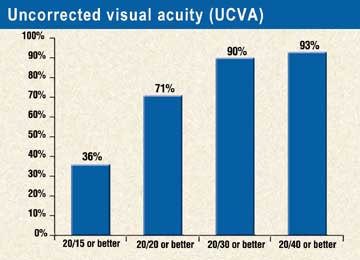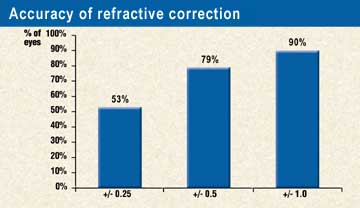Myopic tracker-assisted LASIK safe and predictable
A British study is assessing the Alcon Summit Autonomous scanning/tracker laser outside FDA parameters.
LIVERPOOL, England — The Alcon Summit Autonomous scanning/tracking laser (Fort Worth, Texas) for correction of myopic astigmatism is safe and highly predictable, according to a study outside Food and Drug Administration parameters.
“This is an ongoing, prospective study of all patients undergoing T-LASIK, or tracker-assisted LASIK,” said investigator Deepak K. Chitkara, FRCOphth, DO, a consultant ophthalmic surgeon at the Rosen Eye Surgery Centre here. Between May 1998 and December 1999, Dr. Chitkara and his colleagues treated 306 eyes. By July 2000, the investigators had 12-month follow-up data on 129 of these eyes, which they presented at the American Academy of Ophthalmology meeting in Dallas.
Mean patient age was 38; half the patients in the presbyopic group were over 40 years old. “Most of those patients were treated for monovision correction,” Dr. Chitkara said. Preop spherical equivalent was –4.66 D (range –13 D to –0.5 D). “The one –13 D patient was part of a bioptic treatment. We were aiming to reduce her myopia to about 3 D or 4 D of residual myopia.”
Most surgeries consisted of a 6.5-mm treatment zone, along with a 1-mm blend zone. Still, a high percentage of the spherical myopes were treated at 6-mm treatment zones.
Safe procedure
Regarding safety outcomes, 84% of patients had either no loss of vision or gained best corrected visual acuity (BCVA). Only 14% lost one line of vision, and 2% lost two lines. The scattergram also showed very tight predictability. One patient was treated for –12 D and ended up slightly undercorrected. Also, “one or two patients were slightly overcorrected, but the scattergram appears to be very, very tight,” Dr. Chitkara said
Further, 79% of patients were within 0.5 D of intended correction. “More importantly, though, more than half our patients (53%) were within 0.25 D of the attempted correction,” he said. The stability of the procedure was also excellent, with stability achieved at 1 month. “This was the first time point where our data was measured. The stability was virtually identical throughout the year.”
Uncorrected visual acuity was a secondary outcome measure because the study included a large number of patients treated for monovision; 71% of patients were 20/20 or better uncorrected. More importantly, 36% actually achieved 20/15 or better.
The study also found a small amount of induced cylinder, both overcorrection and undercorrection. “By looking at it more graphically with a double angle plot, the vector analysis shows a very small amount of induced cylinder, which is not really significant,” he said.
Re-treatment
 Of the 129 eyes with
12-month follow-up data, 16 (12%) were re-treated. “Over 90% of these
re-treated eyes were due to patients who were originally treated for
monovision, but were not happy with the results of their monovision
situation,” Dr. Chitkara said. Still, 14 of the 16 re-treated eyes were
within 0.5 D of the intended correction after re-treatment, and 13 of the eyes
were within 0.25 D.
Of the 129 eyes with
12-month follow-up data, 16 (12%) were re-treated. “Over 90% of these
re-treated eyes were due to patients who were originally treated for
monovision, but were not happy with the results of their monovision
situation,” Dr. Chitkara said. Still, 14 of the 16 re-treated eyes were
within 0.5 D of the intended correction after re-treatment, and 13 of the eyes
were within 0.25 D.
Among the first several cases, nine eyes also had debris under the flap. “Most of these we watched. They finally settled and did not affect final visual acuity, except in one patient. We had great difficulty examining the eyes through the optics of the microscope. The optics were subsequently changed, and in the last few cases we have no incidence of actual debris under the flap,” he said.
One study eye appeared to have a decentered ablation, which was surprising considering the use of a tracker. “This patient had a very unstable eye. He was rolling throughout the procedure and we believe it wasn’t really a decentration,” Dr. Chitkara said. The procedure for this patient took 5 minutes. “We had to keep stopping and starting the treatment. The result may have been due to an irregular ablation because of the prolonged time it took to complete the procedure.”
Dry eye pervasive
 One interesting
finding of the study is that by checking carefully, every patient developed dry
eye syndrome, but most patients did not complain. “In 10% of cases,
though, the dry eye was severe enough for us to administer punctal
occlusion,” Dr. Chitkara said. There were also two cases of diffuse
lamellar keratitis grade 2+, which were treated vigorously with steroids and
resolved. “One of those patients actually suffered a flap melt
peripherally, but had uncorrected vision of 20/50.” The same patient had
previously undiagnosed, severe blepharitis which was not treated
preoperatively.
One interesting
finding of the study is that by checking carefully, every patient developed dry
eye syndrome, but most patients did not complain. “In 10% of cases,
though, the dry eye was severe enough for us to administer punctal
occlusion,” Dr. Chitkara said. There were also two cases of diffuse
lamellar keratitis grade 2+, which were treated vigorously with steroids and
resolved. “One of those patients actually suffered a flap melt
peripherally, but had uncorrected vision of 20/50.” The same patient had
previously undiagnosed, severe blepharitis which was not treated
preoperatively.
“We feel the Autonomous tracking laser is safe, particularly given the fact that 23% of eyes gained BCVA and 61% were unchanged. The system is also highly predictable.” Also, complications were few. “They occurred early in our assessment of the laser, and are largely avoidable,” Dr. Chitkara said. He also noted the laser is extremely easy to use and re-treatments are very predictable.
The LadarVision laser is FDA-approved for the LASIK treatment of hyperopia, hyperopia with astigmatism and mixed astigmatism.
For Your Information:
- Deepak K. Chitkara, FRCOphth, DO, can be reached at 66 Dowhills Rd., Blundellsands, Liverpool L238SP UK; (44) 161 248 7400; fax: (44) 151 932 0705; e-mail: dchitkara@cableinet.co.uk. Dr. Chitkara has no direct financial interest in the products mentioned in this article, nor is he a paid consultant for any companies mentioned.
- Alcon Summit Autonomous, manufacturer of the scanning/tracker laser, can be reached at 6201 South Freeway, Fort Worth, TX 76134; (800) 826-5266; fax: (817) 241-0677.
